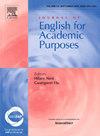Transvocal stance in academic translation: A rhetorical analysis of grammatical stance in translated applied linguistics English research article abstracts
IF 3.4
1区 文学
Q1 EDUCATION & EDUCATIONAL RESEARCH
引用次数: 0
Abstract
Translators of academic texts mediate source-language constraints and English as a Lingua Franca (ELF) academic norms, often leading to varied representations of authorial stance. However, this “third code” of translational academic language, distinct from both source and target languages, remains underexplored. This research addresses this gap by examining the transvocal presence of authorial and translatorial stances in Chinese-to-English applied linguistics research article abstracts (RAAs). It explores the addition, cross-type transfer, and direct transfer of four types of stance-taking grammatical devices into translated English RAAs and their rhetorical roles across five moves, supported by statistical analysis. The study finds that translators prefer the use of modal and epistemic devices, followed by communicative and attitudinal resources, and they engage asymmetrically with both stance-rich (i.e., findings, discussions) and less stance-rich moves. There is a balanced distribution of translatorial and authorial stances across moves in attitudinal, communicative, and modal devices. However, authorial epistemic stance is largely preserved in presenting findings. These findings highlight a complex interlingual mechanism in academic translation, where micro-level changes in lexico-grammatical features impact the macro-level discursive landscape. It showcases translators’ professional agency in selectively deploying translatorial and authorial stances across moves of RAAs.
学术翻译中的传意立场:应用语言学英语研究论文摘要翻译中语法立场的修辞分析
学术文本的译者调解源语言约束和英语作为通用语(ELF)的学术规范,往往导致不同的作者立场的表现。然而,这种不同于源语和目的语的翻译学术语言的“第三种规范”仍未得到充分的探索。本研究通过考察汉英应用语言学研究论文摘要(RAAs)中作者和翻译立场的显性存在来解决这一差距。本文以统计分析为依据,探讨了四种表示立场的语法手段在英语RAAs翻译中的添加、跨类型迁移和直接迁移,以及它们在五步中的修辞作用。研究发现,译者更喜欢使用情态和认知手段,其次是交际和态度资源,并且他们对立场丰富(即发现、讨论)和立场较少的动作的使用是不对称的。翻译和作者的立场在态度、交际和情态手段上的分布是平衡的。然而,作者的认识论立场在很大程度上保留了提出的发现。这些发现突出了学术翻译中复杂的语际机制,其中微观层面词汇语法特征的变化影响着宏观层面的话语景观。它展示了译者的专业代理,有选择地在RAAs的动作中部署翻译和作者的立场。
本文章由计算机程序翻译,如有差异,请以英文原文为准。
求助全文
约1分钟内获得全文
求助全文
来源期刊

Journal of English for Academic Purposes
Multiple-
CiteScore
6.60
自引率
13.30%
发文量
81
审稿时长
57 days
期刊介绍:
The Journal of English for Academic Purposes provides a forum for the dissemination of information and views which enables practitioners of and researchers in EAP to keep current with developments in their field and to contribute to its continued updating. JEAP publishes articles, book reviews, conference reports, and academic exchanges in the linguistic, sociolinguistic and psycholinguistic description of English as it occurs in the contexts of academic study and scholarly exchange itself.
 求助内容:
求助内容: 应助结果提醒方式:
应助结果提醒方式:


